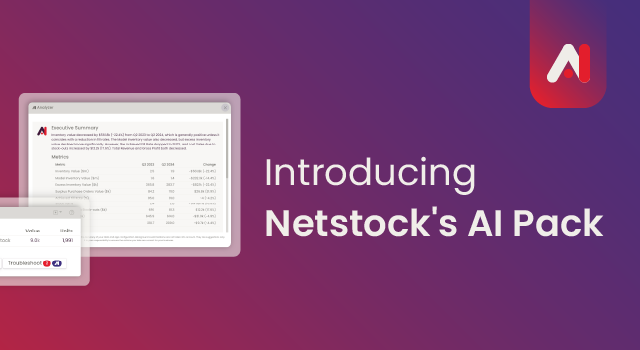What’s in this blog?
Effective inventory management is vital for any business dealing with physical products. However, it’s often easier said than done. You need to determine the right inventory levels, avoid stock-outs and excess stock, coordinate with suppliers, and keep up with changing demand; this can quickly become overwhelming, especially if you’re managing inventory manually.
Automated replenishment software takes the guesswork out of inventory planning by using advanced technologies like artificial intelligence (AI), machine learning, and real-time data integration. It enables accurate forecasting, optimizes inventory levels, streamlines ordering processes, and ultimately accelerates your efficiency and profitability.
In this post, we discuss automated replenishment software, its benefits across industries, implementation strategies, and the advanced ordering techniques it will unlock for your business.
Understanding automated replenishment software
Automated replenishment software is a powerful inventory management tool that helps businesses maintain optimal stock levels. This software is designed to provide accurate demand forecasting and automated reordering recommendations by analyzing historical sales data, current inventory positions, supplier lead times, and other relevant factors to predict future demand.
The key functionalities of replenishment software include:
- Demand forecasting using advanced algorithms like time-series analysis
- Calculating ideal reorder points and quantities based on your desired service levels
- Generating purchase orders for replenishment automatically when inventory levels drop below specified thresholds.
- Monitoring supplier performance metrics like on-time delivery
- Seamlessly integrating with existing ERP (Enterprise Resource Planning) systems to synchronize data and streamline operations.
- Providing insights and analytics on inventory performance, such as turnover rates, carrying costs, and stock-out occurrences.
Automated replenishment brings efficiency across industries like manufacturing, food and beverage, pharmaceuticals, automotive parts, and more, whether in small retailers or large omnichannel enterprises. It’s designed to eliminate manual intervention, reduce stock-outs and overstocking, and free up working capital.
How automated replenishment software works
Modern automated replenishment uses artificial intelligence (AI) and machine learning models to analyze large datasets and identify demand patterns. Compared to traditional methods, this allows for highly accurate sales forecasting.
The software factors in historical sales data, pricing, promotions, seasonality, and other variables to predict future requirements. It then optimizes inventory levels and reorders accordingly via integration with your enterprise resource planning (ERP) system.
Internet of Things (IoT) connectivity plays an important role by providing real-time inventory data from smart warehouses and sensors. This ensures your replenishment plans align with ground reality and quickly adapt to fluctuations.
Automated replenishment software empowers businesses to optimize their inventory management processes, reduce costs, and enhance customer satisfaction by leveraging AI, machine learning, IoT, and smart warehouse technologies.
Core benefits of automated replenishment software
Adopting an automated replenishment solution brings a multitude of benefits that drive efficiency, cost savings, and customer satisfaction across your supply chain operations:
Increased efficiency: Automating ordering processes and inventory optimization eliminates tedious manual tasks and human errors, allowing your team to focus on higher-value activities.
Cost reduction: Accurate demand forecasting minimizes excess inventory carrying costs. Just-in-time replenishment based on real requirements translates to lower working capital requirements.
Customer satisfaction improvements: Precise inventory level management ensures high product availability. This reduces stockouts and backorders and improves overall fill rates and on-time deliveries.
The impact is evident across company sizes. Large retailers like Walmart have used automation to significantly reduce out-of-stock, while small to medium businesses like The Little Potato Company achieved over 8% improvement in their fill rate with automation software.
Choosing the right replenishment software
There are many replenishment software options available in the market so selecting the right fit is vital. Start by evaluating your key requirements like the number of stock-keeping units (SKUs), your integration needs, advanced features, and the level of inventory management you need:
Cost: understand the licensing model, implementation fees, maintenance, and training costs involved.
Features: assess forecasting methods, optimization capabilities, multi-location management, and reporting/analytics tools offered.
Scalability: as your business grows, the software should be able to seamlessly handle more products, locations, and transaction volumes.
Integrations: the solution should integrate with your existing ERP, warehouse management, and accounting systems.
Support: review the training, documentation, and ongoing technical assistance provided by the vendor.
Optimal ordering strategies
Once you have an automated replenishment system in place, you can take inventory optimization a step further by implementing advanced ordering strategies:
The Economic Order Quantity (EOQ) Formula: this calculates the ideal order quantity by balancing ordering costs and carrying costs. The EOQ helps minimize total inventory costs.
Reorder Point Formula: set smart reorder points factoring in lead times and buffer stocks. This prevents stockouts by triggering replenishment before you run out. Learn more about reorder point formula.
You can also capitalize on Collaborative Planning, Forecasting, and Replenishment (CPFR), a structured approach to coordinating your forecasts and plans with key suppliers and customers.
Your automated system ensures you always have the right product quantities aligned with demand by combining EOQ, reorder points, and collaborative forecasting
For a deeper understanding, check out our article on using the EOQ
Implementation Strategies
Integrating an automated replenishment solution involves several steps, each critical for a successful transition. Follow these strategies to ensure a smooth implementation:
- Assess current state: Audit your existing inventory data, processes, and systems before selecting new software.
- Data preparation: Clean up historical sales, inventory, and supplier records to ensure accurate forecasting inputs.
- Test and pilot: Run parallel testing with your new system before fully transitioning. Start with a few high-runner SKUs.
- Staff training: Have your implementation partner provide role-based training for planners, buyers, and IT teams.
- Ongoing monitoring: Continuously monitor key metrics like forecast accuracy and safety stock levels to refine settings.
The most common challenges are data quality issues, system integration gaps, and employees resisting change. However, partnering with an experienced solution provider can help mitigate these risks.
Maximizing efficiency with automated replenishment software
Automating your inventory replenishment process is essential for your business success and offers numerous benefits for your business, including minimizing stock-outs, reducing excess inventory costs, boosting customer satisfaction, and ultimately improving your bottom line. By freeing your business from manual processes, you’ll be able to be proactive and agile in meeting evolving market demands. This will enable you to maintain a competitive edge and better serve your customers.




